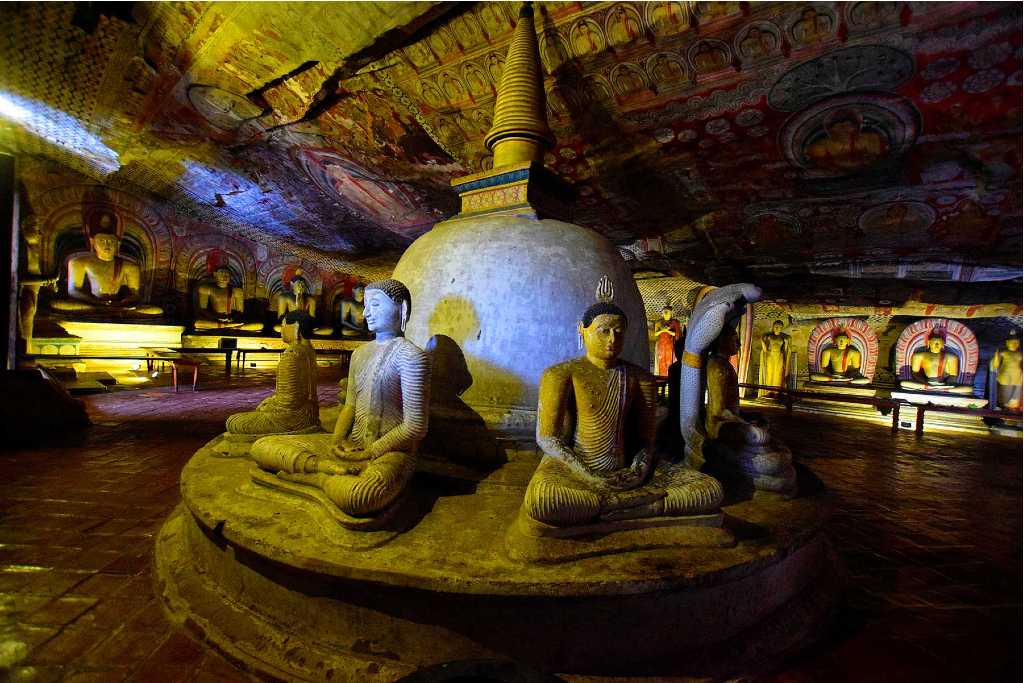Dambulla cave temple (or Dambulla golden temple) is a UNESCO World Heritage site located in the Dambulla district of Sri Lanka. Since its monastic beginnings in the first century BCE, the cave temple was home to thousands of meditating monks. Today the same cave temple hosts a massive collection of Buddhist murals and sculptures belonging to a pan-Asian artistic tradition. The cave temple was abandoned at regular intervals since its humble beginnings. Yet the royals and Buddhist elite kept renovating it to appease countless faithful pilgrims.



It is still a Buddhist pilgrimage site and has been so for centuries. Dambulla golden rock cave temple is the official name in the UNESCO list of world heritages. The cave complex’s original name is “Swarna Giri Guha”. Dambulla Rock Caves are, without a doubt, one of the most colorful places in Sri Lanka. It is also a place rich in legends and histories. The caves are easily accessible, unlike the spread-out historical sites you often find in Sri Lanka. They hide under a single overhanging rock.
These caves stand 160 meters above ground, facing spectacular views of the surrounding plains. The five caves were dug out by royal artisans and compartmentalized with brick walls. None of the caves receive natural light. Most murals are hidden in darkness, creating a mystic balance of color. The floors of Dambulla caves are crammed with more than 140 Buddha statues. Statues of local deities, aspirant Buddhas, and patron kings also peek out here and there. The oldest murals and sculptures at Dambulla caves are dated back to the twelfth century.
Dambulla Rock Cave Temple Highlights
Deva Raja Lena Caves
In the legends, the first cave is called “Devaraja Lena”. The literal meaning of the name is the cave of the god-king. A Brahmi inscription above the cave describes how the first monastery was founded by “Gamani Tissa” around the first century BCE. Traditionally this name is believed to be of King Vatta Gamini Abhaya, aka Valagamba.
The cave feels a bit crammed up because of an exquisite 14-meter statue of the Buddha. The statue is hewn out of the existing rock. It probably received its last coat of paint in the early twentieth century. At the Buddha statue’s feet is a sculpture of monk Ananda. At the head is a statue of the god Vishnu.
Maha Raja Lena Cave
“Maha Raja Lena” means the cave of the great king. Maha Raja Lena cave is architecturally distinct. It is certainly the most beautiful of the five caves. Fine murals completely cover the ceiling and the walls. Most of them are drawn in strip panels, which follow the artistic tradition of pre-colonial Sri Lanka. Interesting murals are the first sermon of Buddha, the dream of the great Maya, the defeat of Mara, and the daughters of Mara. Countless Buddha statues showing colorful traditional postures adorn the cave floor.
The highlight of the cave is the statue of Buddha, surrounded by aspirant Buddhas. The arch around the Buddha is called a traditional Makara Torana. Makara Torana translates to dragon arch. Right behind are statues and paintings of Hindu gods who later became associated with Buddhist folklore. Rare statues of kings Vatta Gamaini Abhaya and Nissankamalla are hidden behind some Buddha statues.
Maha Aluth Viharaya Cave
This is an 18th-century addition by King Kirti Sri Raja Singha of Kandy. The name of Maha aluth viharaya simply means the grand new temple. The cave certainly retains a sense of grandeur. The murals in this cave show the aspirant Buddha Maitreya. There are more than 50 statues in this cave. The larger meditating Buddha and sleeping Buddha are carved out of the existing rock. Probably the only statue of King Kirti Sri Raja Singha is found at the entrance to the cave.




Paccima Viharaya
Paccima viharaya means the western temple. It is a later addition and smaller than the other three caves. Among many statues of Buddha stands a beautiful dragon arch (Makara Torana). A small stupa monument stands in the middle of this cave. It is believed that the jewelry of queen Somawathi was deposited in this stupa. Early twentieth-century restorations make the murals in this cave very colorful.
Devena Aluth Viharaya
The smallest cave of five is known as the second new temple or Devana Aluth Viharaya. It was the last addition to the Dambulla golden rock cave temple. A sleeping Buddha takes most of the cave space. Around the statue are murals of god Vishnu, god Kataragama, a peacock, popular local deity Bandara, and a nobleman holding a lotus. This selection of characters best displays the contemporary belief system of Sri Lankan Buddhism.
Cultural Tours in Sri Lanka- Explore More
Front Corridor and Courtyard of the Dambulla Rock Cave Temple Complex
The pathway to all five caves is through a beautiful whitewashed corridor built in the early twentieth century. It distinctly highlights British colonial architecture. On the outer side of the corridor is an atmospheric space from which you can glimpse the huge rock above the caves. An ancient drip ledge runs along the whole length of the cave complex to prevent water from seeping into the cave ceiling. A Brahmi inscription can be seen above this drip ledge. To the Eastern side is a Sacred Fig tree and right at the beginning of the cave complex is an eleventh-century inscription about King Nissankamalla of Polonnaruwa.
